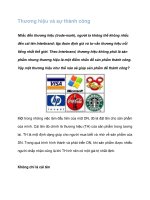Tài liệu thương hiệu B2C phần 1 pot
Bạn đang xem bản rút gọn của tài liệu. Xem và tải ngay bản đầy đủ của tài liệu tại đây (139.48 KB, 5 trang )
CHAPTER 1
Being Known or
Being One of Many
“It is a capital mistake to theorize before one has data. Insensibly one
begins to twist facts to suit theories, instead of theories to suit facts.”
Sir Arthur Conan Doyle (1859-1930), Sherlock Holmes
When talking about brands most people think of Coca Cola, Apple,
Ikea, Starbucks, Nokia, and maybe Harley Davidson. These brands also
happen to be among the most cited best-practice examples in the
area of Business-to-Consumer (B2C) branding. For these companies
their brand represents a strong and enduring asset, a value driver
that has literally boosted the company’s success. Hardly any com-
pany neglects the importance of brands in B2C.
In Business-to-Business (B2B), things are different – branding is
not meant to be relevant. Many managers are convinced that it is a
phenomenon confined only to consumer products and markets.
Their justification often relies on the fact that they are in a commod-
ity business or specialty market and that customers naturally know
a great deal about their products as well as their competitors’ prod-
ucts. To them, brand loyalty is a non-rational behavior that applies
to breakfast cereals and favorite jeans – it doesn’t apply in the more
“rational” world of B2B products. Products such as electric motors,
crystal components, industrial lubricants or high-tech components
are chosen through an objective decision-making process that only
accounts for the so-called hard facts like features/functionality,
2 Being Known or Being One of Many
benefits, price, service and quality etc.
1
Soft-facts like the reputation
of the business, whether it is well known is not of interest. Is this
true? Does anybody really believe that people can turn themselves
into unemotional and utterly rational machines when at work? We
don’t think so.
Is branding relevant to B2B companies? Microsoft, IBM, General Elec-
tric, Intel, HP, Cisco Systems, Dell, Oracle, SAP, Siemens, FedEx, Boeing –
they are all vivid examples of the fact that some of the world’s
strongest brands are B2B brands. Although they also operate in
B2C segments, their main business operations are concentrated on
B2B. Then why are so many B2B companies spurning their fortune?
Take for instance the Boeing company. Only a few years ago a very
interesting incident happened at the Boeing headquarters in Seattle.
Shortly after Judith A. Muehlberg, a Ford veteran started as head of
the Marketing and Public-Relations department, she dared to utter
the “B” word in a meeting of top executives. Instantly, a senior
manager stopped her and said: “Judith, do you know what industry
you’re in and what company you’ve come to? We aren’t a con-
sumer-goods company, and we don’t have a brand.”
2
Since then US
aerospace giant Boeing has come a long way. Nowadays, branding
and brand management do matter in a big way to them. In 2000, the
company’s first-ever brand strategy was formalized and integrated
in an overall strategy to extend its reach beyond the commercial-
airplane business. Today, the brand spans literally everything from
its logo to corporate headquarters. Even the plan to relocate its cor-
porate headquarter from Seattle to Chicago has been devised with
the Boeing brand in mind.
3
In 2005, Boeing introduced its new flag-
ship aircraft. In a worldwide campaign with AOL, they searched for
a suitable name and invented the Dreamliner, which was inaugu-
rated by Rob Pollack, Vice President of Branding for Boeing Com-
mercial Airplanes Marketing.
4
What is branding all about anyway? First of all we can tell you
what it is not: It is definitely not about stirring people into irrational
buying decisions. Being such an intangible concept, branding is
quite often misunderstood or even disregarded as creating the illu-
Being Known or Being One of Many 3
sion that a product or service is better than it really is.
5
There is an
old saying among marketers: “Nothing kills a bad product faster
than good advertising.”
6
Without great products or services and an
organization that can sustain them, there can be no successful
brand.
Now you may wonder what branding really is all about. Scott Bed-
bury, author of the book A New Brand World puts it as follows:
7
“Branding is about taking something common and
improving upon it in ways that make it more valuable
and meaningful.”
Brands serve exactly the same general purpose in B2B markets as
they do in consumer markets:
They facilitate the identification of products, services
and businesses as well as differentiate them from the
competition.
8
They are an effective and compelling
means to communicate the benefits and value a product
or service can provide.
9
They are a guarantee of quality,
origin, and performance, thereby increasing the per-
ceived value to the customer and reducing the risk and
complexity involved in the buying decision.
10
Brands and brand management have spread far beyond the tradi-
tional view of consumer-goods marketers. Brands are increasingly
important for companies in almost every industry. Why? For one
thing, the explosion of choices in almost every area. Customers for
everything from specialty steel to software now face an overwhelm-
ing number of potential suppliers. Too many to know them all, let
alone to check them out thoroughly.
For example, Pitney Bowes, one of the winners in Jim Collins’ book
Good to Great,
11
has recently introduced a new branding campaign.
After being on the success track for more than 15 years, they felt it
necessary to educate their customers about all their new products.
Chairman and CEO Michael J. Critelli explained on Bloomberg
Television how Pitney Bowes’ new business-building brand cam-
4 Being Known or Being One of Many
paign will fuel the company’s long-term growth strategy and his
Chief Marketing Officer Arun Sinha elaborated that a brand is more
than a product – it’s a shorthand that summarizes a person’s feel-
ings toward a business or a product. A brand is emotional, has a
personality, and captures the hearts and minds of its customers.
Great brands survive attacks from competitors and market trends
because of the strong connections they forge with customers. And
that is what Pitney Bowes wants to achieve with its B2B customers.
The Internet furthermore brings the full array of choices to every
purchaser or decision maker anywhere with just one mouse click.
Without trusted brands as touchstones, buyers would be over-
whelmed by an overload of information no matter what they are
looking for. But brands do not only offer orientation, they have
various benefits and advantages for customers as well as the “brand
parents”, the originating company. They facilitate the access to new
markets by acting as ambassadors in a global economy.
12
Another important aspect of B2B branding is that brands do not just
reach your customers but all stakeholders – investors, employees,
partners, suppliers, competitors, regulators, or members of your lo-
cal community. Through a well-managed brand, a company re-
ceives greater coverage and profile within the broker community.
13
Other than the biggest misconception that branding is only for
consumer products and therefore wasted in B2B, there are other
common misunderstandings and misconceptions related to B2B
branding and branding in general. One frequently mentioned brand-
ing myth is the assumption that “brand” is simply a name and a
logo. Wrong! Branding is much more than just putting a brand name
and a logo on a product or service.
Take one moment and try to think about what “brand” means to
you personally. Without a doubt certain products, brand names,
logos, maybe even jingles, pop into your head. Many people think
that this is all when it comes to defining brands. But what about the
feelings and associations connected with these products, brands,
companies? What about the articles you read about them? What
Being Known or Being One of Many 5
about the stories you’ve heard about them? What experiences have
you had with those products, brands, companies? We could go on
and pose more questions like these. A brand is an intangible con-
cept. To simplify it and make it easier to grasp is quite often
equated with the more tangible marketing communications ele-
ments that are used to support it – advertising, logos, taglines, jin-
gles, etc – but a brand is so much more than that:
14
• A brand is a promise.
• A brand is the totality of perceptions – everything you see,
hear, read, know, feel, think, etc. – about a product, service, or
business.
• A brand holds a distinctive position in customer’s minds based
on past experiences, associations and future expectations.
• A brand is a short-cut of attributes, benefits, beliefs and values
that differentiate, reduce complexity, and simplify the deci-
sion-making process.
Keeping all this in mind makes it clear that brands cannot be built
by merely creating some fancy advertising. If you internalize the
concept of “brand” as a promise to your customers it is quite obvi-
ous that it can only come to life if you consistently deliver on that
promise. Of course, your brand promise needs to be clearly defined,
relevant and meaningful, not to be mistaken with exaggerated mar-
keting promises.
A further misconception of branding is that it is seen as a small
subset of marketing management. Wrong again! Since a brand is re-
flected in everything the company does, a holistic branding approach
requires a strategic perspective. This simply means that branding
should always start at the top of your business. If your branding
efforts are to be successful, it is not enough to assign a brand man-
ager with a typically short-term job horizon within company.
15
Building, championing, supporting and protecting strong brands is
everyone’s job, starting with the CEO.
16
Active participation of
leaders is indispensable because they are the ones who ultimately









